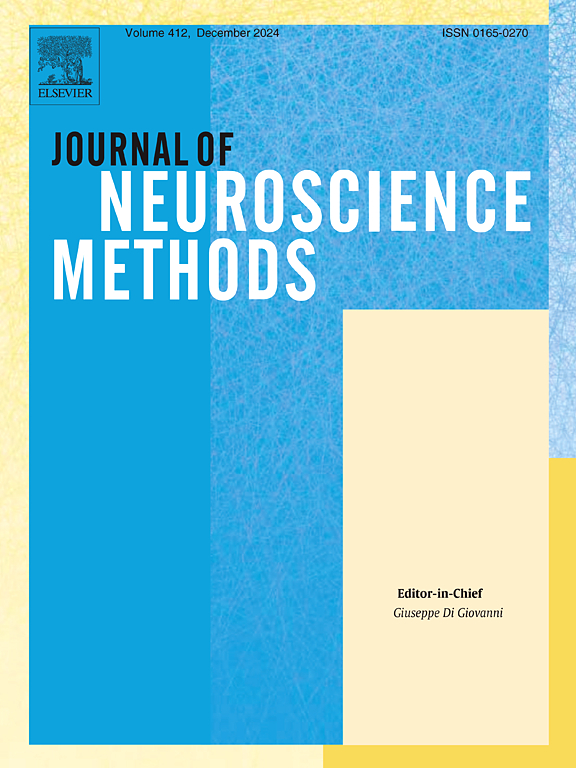A closed-loop approach to monitor and manipulate the neural control of blood pressure
IF 2.7
4区 医学
Q2 BIOCHEMICAL RESEARCH METHODS
引用次数: 0
Abstract
Background
Arterial baroreceptors are mechanosensitive nerve endings that detect blood pressure deviations and transmit this information to the central nervous system via vagal afferent neurons. Vagal afferent neuron cell bodies reside in the nodose ganglion (NG) and they terminate in the nucleus of the solitary tract (NTS) within the brainstem, thus serving as a critical component of the baroreflex circuitry. We previously found that specific angiotensin-sensitive vagal afferent nerve terminals within the NTS (referred to as NTSAT1aR afferents) are sufficient to initiate baroreflex responses in both normotensive and hypertensive conditions.
New method
Here, we developed a closed-loop system in mice to monitor blood pressure and target NTSAT1aR afferents with optogenetic stimulation. To determine the efficacy of the system, mice were subjected to acute pressor stimuli, including restraint or subcutaneous delivery of Ang-II, and delivered optical stimulation by the system until blood pressure returned below threshold.
Results
The closed-loop system is effective in attenuating acute elevations in blood pressure induced by physiological or psychological stressors. by initiating compensatory mechanisms to reduce heart rate and blood pressure. However, blood pressure did return to below threshold levels within similar time frames in stimulated and in stimulation-paired control mice.
Comparison with existing methods
While some existing approaches that lower blood pressure target similar neural pathways, they do not take such a closed-loop tactic.
Conclusion
The implication is that this closed-loop system, coupled with the optogenetic targeting of NTSAT1aR afferents, may be exploited to understand and alleviate hypertension.
一种监测和操纵血压神经控制的闭环方法。
背景:动脉压力感受器是机械敏感的神经末梢,可检测血压偏差并通过迷走神经传入神经元将此信息传递给中枢神经系统。迷走神经传入神经元胞体位于结节神经节(nodose ganglion, NG),终止于脑干内的孤立束核(NTS),因此是压力反射回路的重要组成部分。我们之前发现,NTS内特定的血管紧张素敏感的迷走传入神经末梢(称为NTSAT1aR传入神经)足以在正常和高血压情况下启动压力反射反应。新方法:在这里,我们开发了一个闭环系统来监测小鼠血压和光遗传刺激靶NTSAT1aR传入。为了确定该系统的功效,小鼠受到急性加压刺激,包括抑制或皮下给药Ang-II,并通过该系统给予光学刺激,直到血压恢复到阈值以下。结果:闭环系统通过启动代偿机制降低心率和血压,有效地降低由生理或心理应激源引起的急性血压升高。然而,在刺激和刺激配对的对照组小鼠中,血压确实在相似的时间框架内恢复到阈值以下。与现有方法的比较:虽然一些现有的降低血压的方法针对类似的神经通路,但它们没有采取这种闭环策略。结论:该闭环系统与NTSAT1aR事件的光遗传学靶向可能被用于了解和缓解高血压。
本文章由计算机程序翻译,如有差异,请以英文原文为准。
求助全文
约1分钟内获得全文
求助全文
来源期刊

Journal of Neuroscience Methods
医学-神经科学
CiteScore
7.10
自引率
3.30%
发文量
226
审稿时长
52 days
期刊介绍:
The Journal of Neuroscience Methods publishes papers that describe new methods that are specifically for neuroscience research conducted in invertebrates, vertebrates or in man. Major methodological improvements or important refinements of established neuroscience methods are also considered for publication. The Journal''s Scope includes all aspects of contemporary neuroscience research, including anatomical, behavioural, biochemical, cellular, computational, molecular, invasive and non-invasive imaging, optogenetic, and physiological research investigations.
 求助内容:
求助内容: 应助结果提醒方式:
应助结果提醒方式:


